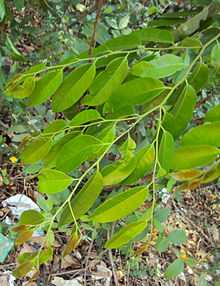Diospyros candolleana
| Diospyros candolleana | |
|---|---|
 | |
| Conservation status | |
| Scientific classification | |
| Kingdom: | Plantae |
| (unranked): | Angiosperms |
| (unranked): | Eudicots |
| (unranked): | Asterids |
| Order: | Ericales |
| Family: | Ebenaceae |
| Genus: | Diospyros |
| Species: | D. candolleana |
| Binomial name | |
| Diospyros candolleana Wight | |
| Synonyms[1] | |
| |
Diospyros candolleana, is a tree in the Ebony family, endemic to the Western Ghats of India and Sri Lanka. The trees are usually 20m tall, and found as subcanopy trees in wet evergreen forests up to 90m.
Description
The bark of D. candolleana is smooth, dark, and blaze-reddish in color. Branchlets are terete and show adpressed hairs when young. Leaves are simple, alternate, distichous; petioles are 0.6-1.1 cm long and canaliculate. Leaves are hairy when young, and glabrous when mature. Lamina is about 6-18 x 3.5-7.5 cm in length, shape is oblong to elliptic-oblong.
Apex of the leaf gradually acuminate with blunt tip, sometimes obtuse, base acute to cuneate, margins are entire, coriaceous, glabrous, drying brown. Midrib of the leaf is canaliculate above; secondary nerves are 8-13 pairs,but not prominent; tertiary nerves are obscure.
Flowers are unisexual and dioecious. Inflorescence of Male flowers show axillary clusters on very short tubercles, silky tomentose; and female flowers are sessile, in axillary clusters.
Fruits are as berries, are globose, to 2.5 cm across, glabrous when mature; calyx is persistent, lobes reflexed with wavy margin. A fruit usually bear 4 seeds.
Vernacular names
The plants is known as:
- Sanskrit: Nila viruksha.
- Kannada: Kari mara.
- Tamil: Kari maram.
- Malayalam: Kari.
- Telugu: Jagala ganti.
- Sinhala: Ho-madiriya, Ho Maediriya
Uses
Use extensively in timber production. Timber is hard, and used in building constructions. A decoction of root-bark is used in rheumatism and swellings in traditional medicine.
References
| Wikimedia Commons has media related to Diospyros candolleana. |
